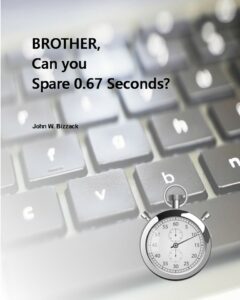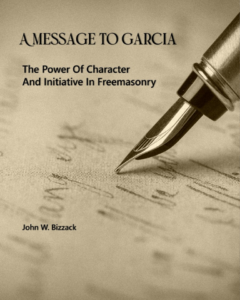Historical change is not a difficult concept to recognize and comprehend. It takes place through the process of cause and effect ― the process by which one thing leads to another, which leads to another, and so on and so forth. Aside from catastrophic events, historical change usually has no single cause, but, rather, a variety of causes that occur over time. This is one reason it is easy to overlook or even ignore emerging patterns that are signals telling us we are in the midst of change―sometimes change that is occurring right beneath our nose―particularly in American Freemasonry. If you are looking for predictions about the future of American Freemasonry built on personal beliefs, anecdotes, opinion, or blinkered speculation commonly found in after-lodge parking lot conversations, this paper will not meet your expectations. If you seek more about where to find, recognize, and consider how both past and current patterns help us to better understand the course of our fraternity, and suggest its future path, this booklet is a suitable primer.
Read MoreVince Lombardi was the legendary coach for the Green Bay Packers from 1959-1968 and then coached the Washington Redskins for one year. His career stats included 96 wins to 34 losses, six Division championships, two conference championships, and winning the first two Super Bowls. He was named Coach of the Year in 1959, was inducted into the hall of fame in 1971, and is the namesake for the current Super Bowl trophy.
Read MoreHow Freemasonry unfolded and evolved as an organization in the United States is an interesting story. One of the fascinating parts of that story is in how clearly becomes the answer to the question as to why much of the fraternity looks and behaves like it does today and faces the same issues as the ones troubling it over the past 160 years or more. The story provokes thought, at least to the non-casual Masons who take the time to study the facts of the unfolding, because it makes clear what happens when a majority of an organization’s culture takes an artless stance, then hones and passes on that stance through generations who cling to the belief that adequate fundamental instruction and education beyond passing through ritual is unnecessary.
Read MoreThe song, Brother, Can You Spare a Dime? was composed for a 1931 Broadway musical called New Americana and originally performed by a man playing a sort of American “everyman.” According to lyricist E.Y. “Yip” Harburg (who later penned Somewhere Over the Rainbow), the song was meant to capture the confused feeling of the Great Depression. “He’s bewildered. Here is a man who had built his faith and hope in this country,” he says of the character. Once everything begins to dwindle, the character cannot accept that the bubble has burst, but he still believes. He still has hope that things will turn around. “He just doesn’t understand what could have happened to make everything go so wrong.”
Read MoreSit down and chat for about ten minutes with an insurance agent, and let him quote you chapter and verse about the death rate among the World War II generation. Okay, I’ll grant you, there’s a certain ghoulish aspect to it. I’m bringing it up because, like Scrooge’s portentous Spectre, Freemasons have spent the last fifteen years pointing an empty sleeve at the grave, and blaming our declining membership numbers on the four-million Masons who were members during our boom years, who have had the very bad timing to pass on to the Celestial Lodge Above in record waves over the last dozen or so years.
Read MoreWhat is Masonry? What is it trying to teach? What does it seek to do? Above all, what can it do for the man who receives it into his heart, loves it, and lives in the light of it? You get the answers to these questions from reading Joseph Fort Newton’s 1924 book, The Men’s House. And the answers come from-a 20th century Mason who viewed Masonry through his faith and embraced a simple insight into the dignity and truths of its principles.
Read MoreWe don’t think much about polishing our shoes these days. In fact, interest in durable leather footwear has been declining for quite some time. The preference for the more casual convenience offered by a variety of informal footwear continues to alarm the leather and the old shoe industry. Droughts over the past decade have affected, and will, for years to come, continue to affect the cattle market, where most leather is produced, which, of course, affects costs in the manufacturing of leather shoes. Also, the onset of more ethically conscious shoppers demanding more alternatives to leather has led designers to utilize fake leather, as well as to companies switching to various other materials to signal their environmental awareness.
Read MoreThe twenty-four-inch gauge is the first working tool given to an Entered Apprentice Mason. We find it described as an instrument of the operative Mason with no authority other than ritual cited. The instrument is not mentioned in the Gothic Constitutions as used in early Masonic ceremonies. In the Edinburg Register House Manuscript (1696), we find it referred to as the “common judge” (a gauge or template). It is first mentioned as the twenty-four-inch gauge in 1724, then again in 1762 in the Masonic exposure, Jachin and Boaz. The term is found again in Thomas Smith Webb’s Freemasons Monitor or Illustrations of Masonry (1797).
Read MoreIn October 1859, the then Grand Master of Kentucky, Rob Morris, asked whether Masonry would survive the causes at work deteriorating it. He also expressed that it was the Masonic knowledge in the few that sustained the Institution when the Masonic knowledge of the many brought it down. In November 2022, Robert G. Davis, Past Grand Master of Oklahoma, delivered a dynamic and timely presentation as the guest speaker at a dinner event in Northern Kentucky sponsored by the William O. Ware Lodge of Research. The title of his presentation was, “It’s Time to Cross the Rubicon and Battle Our 20th Century Ruffians.”
Read MoreA Message to Garcia was originally published as filler without a title in the March 1899 issue of the avant-garde magazine, The Philistine, a periodical published in East Aura, New York. The publication, at the time, was written entirely by American writer, publisher, artist, and philosopher, Elbert Hubbard. Soon after the appearance of the untitled article, orders came for more copies and eventually reprints (reported to be as many as 225 million by 1926) were distributed around the world. The message of the inspirational essay spawned two Hollywood films, was translated into 37 languages, and became well-known in American popular and business culture until the middle of the twentieth century.
Read More


